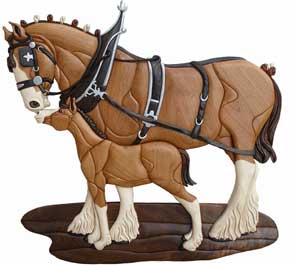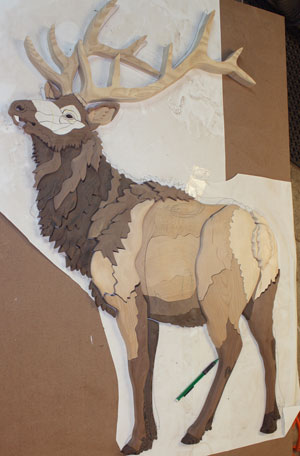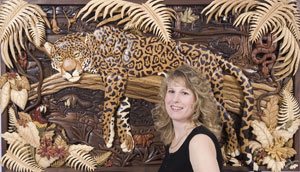
Back when she began working, said Kathy Wise, “People used to collect things.” That worked out well for her, since, after graduating from college with an associate’s degree in commercial art, she began ceramic and clay dogs for her own company. When the president of Enesco, the giftware corporation behind such lines of collectibles as Precious Moments, spotted Kathy’s work, it was the beginning of her 16-year involvement in creating small sculptures for the gift industry.
And then, “People stopped collecting things,” Kathy said. “As that industry was winding down, I started getting more into woodworking.”
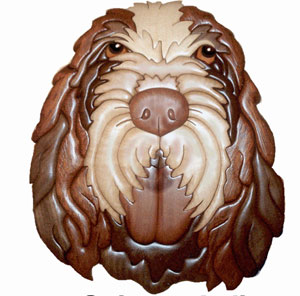
She began making intarsia patterns about 15 years ago, after her father-in-law received requests from his customers at craft fairs for intarsia of specific dog breeds. He couldn’t find patterns, and asked Kathy to make some for him. “I’ve done Portugese water dogs, and all kinds of unusual breeds,” she said. Currently, she has about 175 different dog breed intarsia patterns. “I thought, ‘I have these; I’ll see if anyone else wants them,'” she said about her decision to begin selling her intarsia patterns. She also began doing intarsia herself.
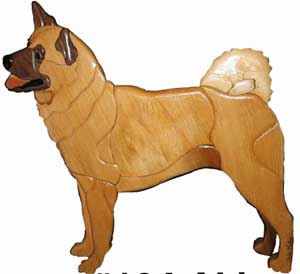
Her previous experiences included carving materials such as soap, stone and wood (including a full-size carousel rocking horse for her young daughter). “I had done mostly three-dimensional sculptural work, so going to intarsia, with two dimensions, was really quite easy for me.” Kathy says she enjoys working with wood, “with all the different colors of wood, and the grain: it’s a fun medium.” She particularly likes the colors of black walnut and cherry, and likes to use wenge for dark coloring. “I like to use a nice range of lights and darks” in a piece, she said.
Kathy notes, however, that she is not a “purist”: “I’ll do whatever I think a piece demands” in terms of color, she said. For an image of a mare and colt, she put silver paint on a buckle because she felt the piece needed it. And, for her macaw image, she pointed out that, while macaws are blue, “there’s no such thing as blue wood.” Instead, she applied a light wash of blue paint, letting the grain show through, so that the piece appeared tinted.
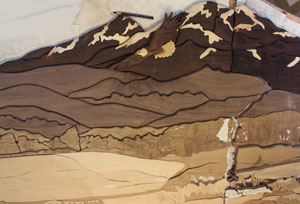
Animals are the subject of most of Kathy’s work: “I’ve always been an animal lover,” she said. “From the time I was young, that’s always been my subject. I just really enjoy the wildlife and dogs and creatures. I don’t mind doing landscapes — as long as I can put some animals into them.”
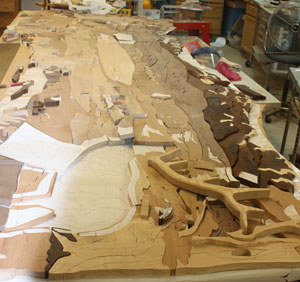
Among those landscapes is a mural she’s currently working on which depicts a scene from the Three Sisters Mountain area of Oregon. “The client’s house is worked into the background,” she explained, while the viewer of the piece will be able to search for and spot a bull elk bugling in the distance of the piece, challenging another bull elk in the front. The murals, Kathy said, do take a lot of time, so that she probably does one large piece a year. They begin with an idea from a client, then a rough sketch, and a full-size paper pattern delivered to their home so they can see it in place. After choosing the wood, she cuts and lays out the mural as a whole on a workboard. She works on smaller sections at a time, then fitting them into the larger setting, adjusting as needed.
One of Kathy’s murals, “Leopard’s Lair,” a 60″ x 40″ piece featuring black walnut and bird’s-eye maple, received the People’s Choice Award at the 2011 San Diego Fine Woodworkers’ Association Design in Wood show. “I was proud because I don’t think an intarsia piece had ever received that before,” Kathy said. Several of her pieces have also received awards in the intarsia category at that show. “It’s the greatest compliment, coming from the great craftspeople at the show.”
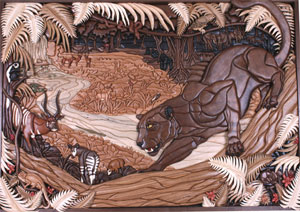
On some of her pieces, Kathy said, she likes to use three dimensions: for example, in her “Tiger Trail” mural, “the tiger’s front paw comes out of the piece five or six inches, so it’s actually coming at you. It’s pretty cool.” She will also add hand carving woodburning detail if she feels a piece needs it. Her usual finish is a clear satin polyurethane, gel or spray, depending upon the complexity of the design.
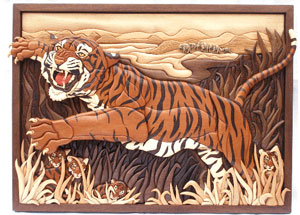
“I rarely do hand sanding,” Kathy said. “I want to get the sanding part of the mural done quickly, and it’s too time-consuming to have to hand sand each piece.” She uses a pneumatic drum sander, and begins with 150-griton an 8″ drum, then moves to 220-grit on a 2″ drum. After any detail carving done by hand or an air die grinder, she’ll take the piece to a sanding mop. “When it’s done, it’s very smooth — and it’s very fast.”
“I sometimes think think people think it’s beyond them to work with intarsia because of the sanding aspect,” Kathy said. “Once you do a couple of pieces and get the basics down, I think it becomes a much easier art form. I’d like to see more people just try it.”
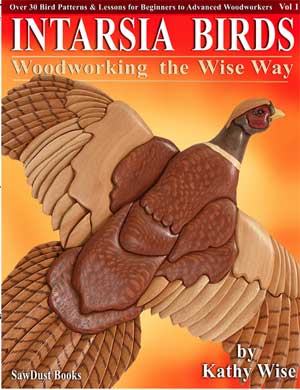
In keeping with that wish, Kathy occasionally gives intarsia classes herself, usually one-on-one with a student, and has also written books on intarsia. Her second book was on intarsia for beginners; her recently released third book, Intarsia Birds: Woodworking the Wise Way, which she wrote and published herself, contains patterns for beginner to advanced woodworkers, covering more than 20 different types of birds. “I kept on getting a lot of requests for birds from different people, unusual birds, like an osprey,” Kathy said,” and I thought it would be nice to do a bird book for them.”
Another way that Kathy says she has “made a lot of people happy” is by creating an intarsia pattern from a photograph of their dog. She’s also done intarsia pieces, with meaning to their owners, of people’s homes, an RV trailer — and a gravel truck. Kathy said, “I just want people to give intarsia a chance.”
